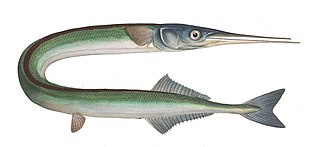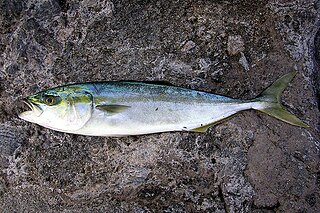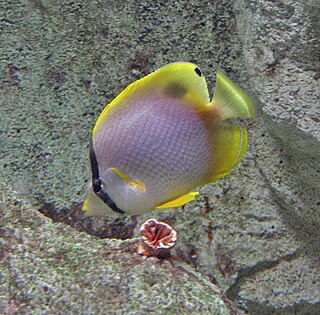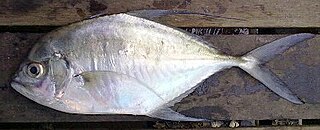
Mackerel is a common name applied to a number of different species of pelagic fish, mostly from the family Scombridae. They are found in both temperate and tropical seas, mostly living along the coast or offshore in the oceanic environment.

Herring are forage fish, mostly belonging to the family Clupeidae.

The garfish, also known as the garpike or sea needle, is a pelagic, oceanodromous needlefish found in brackish and marine waters of the Atlantic Ocean and the Mediterranean, Caribbean, Black, and Baltic Seas.

The Japanese amberjack or yellowtail, Seriola quinqueradiata, is a species of jack fish in the family Carangidae. It is native to the northwest Pacific Ocean, from Korea to Hawaii.

The spotfin butterflyfish is species of marine ray-finned fish, a butterflyfish from the family Chaetodontidae. It is found in the western Atlantic Ocean, in the Gulf of Mexico and most commonly found in the Caribbean Sea.

The silver hake, Atlantic hake, or New England hake is a merluccid hake of the genus Merluccius, found in the northwest Atlantic Ocean. It is highly predatory and typically feeds on fish and crustaceans.
Percina austroperca, the southern logperch, is a small species of freshwater ray-finned fish, a darter from the subfamily Etheostomatinae, part of the family Percidae, which also contains the perches, ruffes and pikeperches. They are highly resilient with a minimum population doubling time of less than 15 months. It is found in the Escambia and Choctawhatchee river systems in western Florida and southern Alabama.

Thunnus is a genus of ocean-dwelling, ray-finned bony fish from the mackerel family, Scombridae. More specifically, Thunnus is one of five genera which make up the tribe Thunnini – a tribe that is collectively known as the tunas. Also called the true tunas or real tunas, Thunnus consists of eight species of tuna, divided into two subgenera. The word Thunnus is the Middle Latin form of the Greek thýnnos – which is in turn derived from thynō. The first written use of the word was by Homer.

Pachypanchax omalonotus, the powder-blue panchax, is a species of Aplocheilid killifish endemic to Madagascar where it is found on the island of Nosy Be and in the Sambirano River basin and adjacent streams on the mainland. Its natural habitat is rivers.

Parascorpaena mossambica, the Mozambique scorpionfish, is a species of Scorpionfish native to the Indian Ocean and the Pacific Ocean to Micronesia. It occasionally makes its way into the aquarium trade. It grows to a length of 10 centimetres (3.9 in) TL.

An anchovy is a small, common forage fish of the family Engraulidae. Most species are found in marine waters, but several will enter brackish water, and some in South America are restricted to fresh water.

Fish are very diverse animals and can be categorised in many ways. This article is an overview of some of ways in which fish are categorised. Although most fish species have probably been discovered and described, about 250 new ones are still discovered every year. According to FishBase, 34,300 species of fish had been described as of September 2020. That is more than the combined total of all other vertebrate species: mammals, amphibians, reptiles and birds.
Penetopteryx is a genus of pipefishes.

The stripey, also known as the footballer or convict fish, is a species of ray-finned fish, a sea chub from the subfamily Microcanthinae which is part of the family Kyphosidae. It is native to the Pacific Ocean where it has a wide range. This species may be found in the aquarium trade. It is the only known member of its genus.

The short-tailed pipefish is a species of fish in the family Syngnathidae. It is found in fresh and brackish waters from Sri Lanka and India east to southern Japan and the Society Islands. It inhabits places with little or no current in rivers, streams and estuaries.

Ulua aurochs, the silvermouth trevally, is a species of trevally in the family Carangidae. It is found in the Indo-Pacific.
The ocellate soapfish is a species of marine ray-finned fish with a wide Indo-Pacific distribution. It is the only species in the genus Grammistops. It is also known as the ocellated soapfish, ocellated podge, or false-eyed soapfish. The specific name ocellatus refers to the ocellate (eye-like) spot on the operculum.
The grey threadfin sea-bass is a species of marine ray finned fish which is a member of the subfamily Serraninae of the family Serranidae, which also includes the groupers and anthias. It is found in the eastern Pacific Ocean off Ecuador and northern Peru and in the Galapagos Islands.














